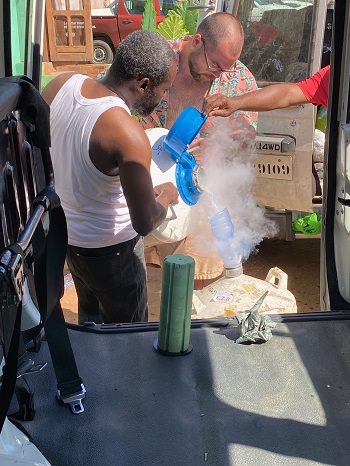Dissimilarities concerning intestine flora and genes from konzo-susceptible regions of the Democratic Republic of Congo (DRC) could affect the release of cyanide soon after poorly processed cassava is eaten, in accordance to a
with 180 young children. Cassava is a food stuff security crop for in excess of fifty percent a billion people today in the establishing entire world. Small children living in significant-danger konzo areas have significant glucosidase (linamarase) microbes and small rhodanese microbes in their intestine, which could necessarily mean a lot more susceptibility and significantly less safety towards the condition, recommend Children’s Nationwide Clinic researchers who led the analyze posted in Nature Communications.
Konzo is a significant, irreversible neurologic condition that final results in paralysis. It occurs soon after consuming poorly processed cassava — a manioc root and essential crop for DRC and other small-profits nations. Inadequately processed cassava consists of linamarin, a cyanogenic compound. Whilst enzymes with glucosidase exercise change starch to basic sugars, they also crack down linamarin, which then releases cyanide into the entire body.
 “Knowing who is a lot more at danger could final result in specific interventions to method cassava improved or try out to diversify the diet,” said
“Knowing who is a lot more at danger could final result in specific interventions to method cassava improved or try out to diversify the diet,” said
The specific organic mechanisms underlying konzo condition susceptibility and severity remained poorly recognized until now. This is the initial analyze to lose mild on the intestine microbiome of populations that depend on harmful cassava as their primary food stuff supply.
“While the intestine microbiome is not the sole trigger of condition supplied that natural environment and malnourishment participate in a position, it is a needed modulator,” stated Matthew S. Bramble, Ph.D., staff scientist at Children’s Nationwide. “Simply said, without having intestine microbes, linamarin and other cyanogenic glucosides would pose minor to no danger to people.”
To realize the affect of a harmful subsistence on the intestine flora and its romance to this debilitating multifactorial neurological condition, the researchers as opposed the intestine microbiome profiles in 180 young children from the DRC working with shotgun metagenomic sequencing. This solution evaluates bacterial variety and detects the abundance of microbes and microbial genes in different environments.
 The samples were being collected in Kinshasa, an urban location with diversified diet and without having konzo Masi-Manimba, a rural location with predominant cassava diet and small prevalence of konzo and Kahemba, a location with predominant cassava diet and significant prevalence of konzo.
The samples were being collected in Kinshasa, an urban location with diversified diet and without having konzo Masi-Manimba, a rural location with predominant cassava diet and small prevalence of konzo and Kahemba, a location with predominant cassava diet and significant prevalence of konzo.
“This analyze overcame several troubles of undertaking study in small-resource settings,” stated Desire Tshala-Katumbay, M.D., M.P.H., Ph.D., FANA, co-senior author and skilled scientist at Institut Nationwide de Recherche Biomédicale in Kinshasa, DRC, and professor of neurology at Oregon Health and fitness & Science University. “It will open up novel avenues to prevent konzo, a devastating condition for several young children in Sub-Saharan Africa.”
For next techniques, the researchers will analyze sibling pairs from konzo-susceptible regions of Kahemba the place only 1 sibling is impacted with the condition.
“Studying siblings will assist us command for elements that can’t be controlled or else, such as the cassava preparation in the house,” stated Neerja Vashist, Ph.D. applicant and study trainee at Children’s Nationwide. “In this operate, each individual sample experienced around five million DNA reads each individual, so for our abide by-up, we system to enhance that to better than 40 million reads per sample and the overall analyze cohort dimension. This analyze style and design will allow us to affirm that the traits we observed maintain on a larger scale, although maximizing our capability to comprehensively characterize the intestine microbiome.”
Media make contact with: Valeria Sabate | 202-476-6741
